An ion is a charged atom, due to an unequal number of protons and electrons.
If the number of protons is greater than the number of electrons, a positively charged ion, or cation, is formed. If the number of protons is less than the number of electrons, a negatively charged ion, or anion, is formed.
Remember that the number of protons cannot be altered, as the number of protons determines the identity of an element.
What would be required for fluorine to form the ion F - ?
- Fluorine would gain one proton.
- Fluorine would gain one electron.
- Fluorine would lose one electron.
- Fluorine would lose one proton.
Fluorine would gain one electron.
Ex.
In order for fluorine to form the ion F - , fluorine would gain one electron , to become a negatively charged ion, or an anion.
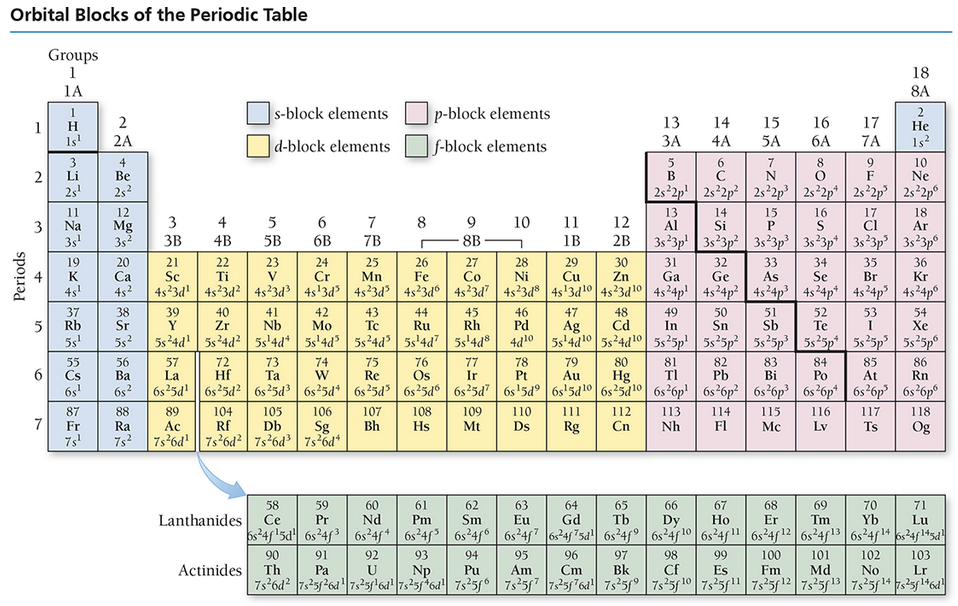
An ion is a charged atom, due to an unequal number of protons and electrons.
If the number of protons is greater than the number of electrons, a positively charged ion, or cation, is formed. If the number of protons is less than the number of electrons, a negatively charged ion, or anion, is formed.
Remember that the number of protons cannot be altered, as the number of protons determines the identity of an element.
If nitrogen were to gain three electrons, what would be the resulting ion?
- N3+
- Ne
- N3-
- He
N 3-
Ex.
N 3- would be the resulting ion, if nitrogen were to gain three electrons.
When an element gains electrons, the number of electrons is greater than the number of protons, resulting in a negative charge. Because nitrogen gained a total of three electrons, the resulting ion, or anion, would have a 3- charge.
What element has the symbol Be? This element is in group 2A(2) which includes the alkaline earth metals. It has the same outer electron configuration as the other alkaline earth metals, ns 2 .
What element has the symbol Be?
- Bromine
- Barium
- Boron
- Beryllium
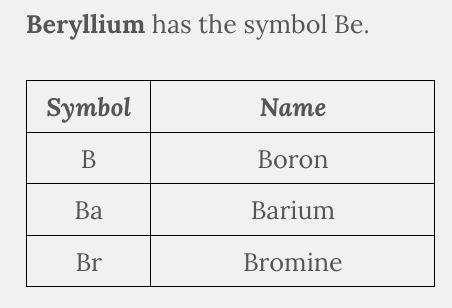
Beryllium
What element has the symbol V? This element is in the early transition metal series which includes group 5B(5). It has the predicted outer electron configuration for the group, ns 2(n-1)d 3.
What element has the symbol V?
- Ytterbium
- Yttrium
- Tungsten
- Vanadium
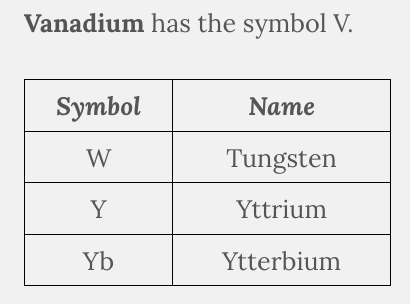
Vanadium
Isotopes are atoms of the same element that have the same number of protons but a different number of neutrons. Therefore, isotopes have the same atomic number (number of protons) but a different mass number (number of protons plus number of neutrons). Typically, the mass number is written as a superscript in front of the elemental symbol.
Which of the following pairs are isotopes of each other?
- 70Ga and 69Ga
- 18O and 18F
- 39K and 45Sc
- 55Mn and 55Fe
70 Ga and 69 Ga
Ex.
70 Ga and 69 Ga are isotopes of one another, as they are the same element and therefore have the same number of protons. However, 70 Ga and 69 Ga have a different mass number, resulting in a different number of neutrons.

Mole is a Latin word for “pile.” More specifically, a mole is a pile that contains 6.022 × 10 23 particles or objects. These particles are typically atoms, molecules, or ions. A mole is a counting number that means 6.022 × 10 23 just as a dozen means 12.
With this in mind, we can now create a conversion factor that can be used to determine the number of particles in a mole (or “pile”) or vice versa.
When using this conversion factor, you will replace “particles” with the chemical identity of the substance you are using, as well as identifying if the substance is found as atoms, molecules, or ions.
Calculate the number of moles of silicon, Si, if you begin with 5.84 × 10 24 atoms of silicon.
- 1.03 × 10-47 moles of Si
- 9.70 x 1046 moles of Si
- 9.70 moles of Si
- 0.103 moles of Si

9.70 moles of Si
What element has the symbol Si? This element is in group 4A(14) which includes nonmetals, metalloids, and metals. It has the same outer electron configuration as the other elements in this group, ns 2 np 2.
What element has the symbol Si?
- Silver
- Sodium
- Scandium
- Silicon
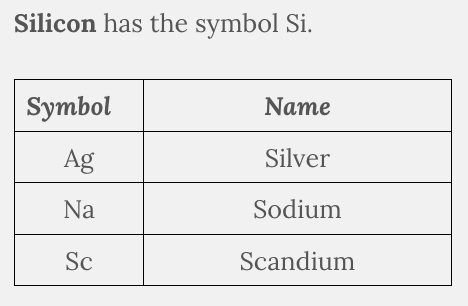
Silicon
Atoms contain a combination of protons, neutrons, and electrons which gives an atom its properties and makes it possible to predict their reactivity, including which ion(s) will form from that element.
Of protons, neutrons, and electrons, which one(s) are found in the nucleus and which one(s) are found outside the nucleus?
- Protons are found in the nucleus, whereas neutrons and electrons are found outside the nucleus.
- Electrons and neutrons are found in the nucleus, whereas protons are found outside the nucleus.
- Protons and neutrons are found in the nucleus, whereas electrons are found outside the nucleus.
- Neutrons are found in the nucleus, whereas protons and electrons are found outside the nucleus.
Protons and neutrons are found in the nucleus, whereas electrons are found outside the nucleus.
Ex.
The nucleus contains protons and neutrons and is very dense with a positive charge. Electrons are located outside of the nucleus. Most of the volume of an atom is empty.
What is the symbol for the element krypton? Krypton is in group 8A(18) which includes nonmetals. It is called the noble gas group. It has the same outer electron configuration as the other elements in this group, ns 2 np 6.
What is the symbol for krypton?
- Ky
- K
- Kn
- Kr
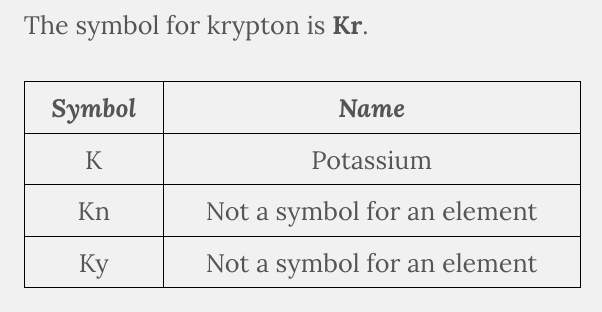
Kr

Isotopes are atoms of the same element that have the same number of protons but a different number of neutrons. Therefore, isotopes have the same atomic number (number of protons) but a different mass number (number of protons plus number of neutrons).
The following designation—the atomic symbol—is used to represent different isotopes of an element:
“A” is the mass number, “Z” is the atomic number, and “X” is the chemical symbol of the element.
Select the atomic symbol that would represent an isotope with 13 protons and 14 neutrons.
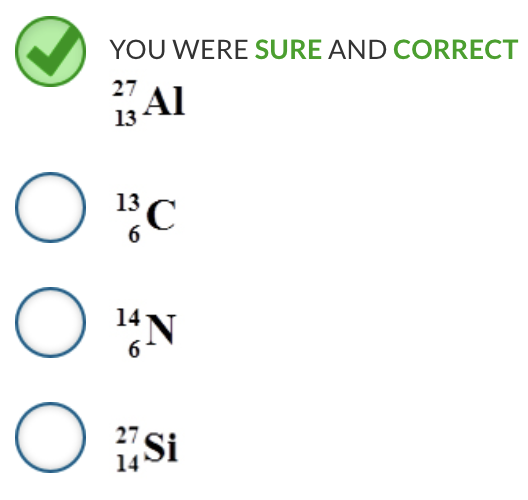
27/13 Al
Ex.
An isotope containing 13 protons and 14 neutrons must be an isotope of aluminum, as aluminum has an atomic number of 13, which is the number of protons. Because the number of neutrons in this isotope is 14, the mass number must be 27 (number of protons plus the number of neutrons). Therefore, the correct designation for an isotope containing 13 protons and 14 neutrons is:
27/13 Al
Notice that the mass number is written above the atomic number and before the elemental symbol in the designation for an isotope.
What element has the symbol Al? This element is in group 3A(13) which includes metalloids and metals. It has the same outer electron configuration as the other elements in this group, ns 2 np 1.
What element has the symbol Al?
- Aluminum
- Arsenic
- Argon
- Gold
- Silver
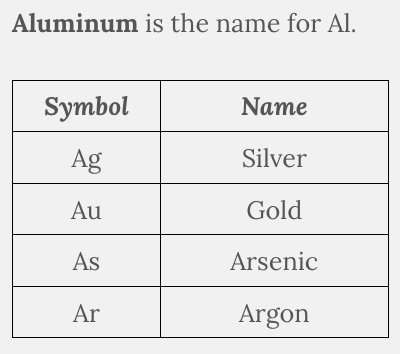
Aluminum
What element has the symbol Li? This element is in group 1A(1) which includes the alkali metals. It has the same outer electron configuration as the other alkali metals, ns 1 .
What element has the symbol Li?
- Lanthanum
- Lithium
- Lawrencium
- Lutetium
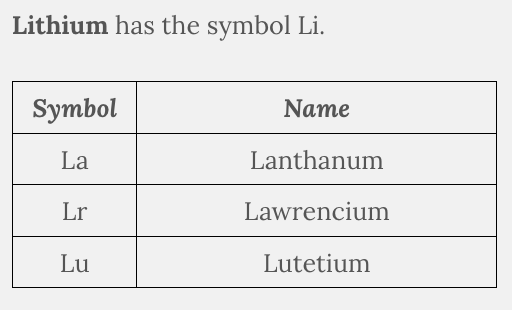
Lithium
What element has the symbol N? This element is in group 5A(15) which includes nonmetals, metalloids, and metals. It is sometimes called the pnictogen group. It has the same outer electron configuration as the other elements in this group, ns 2 np 3.
What element has the symbol N?
- Sodium
- Neon
- Nickel
- Nitrogen
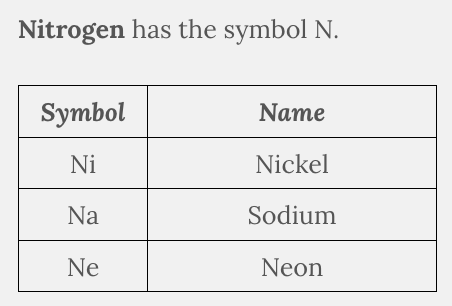
Nitrogen
What element has the symbol S? This element is in group 6A(16) which includes nonmetals, metalloids, and metals. It is sometimes called the chalcogen group. It has the same outer electron configuration as the other elements in this group, ns 2 np 4.
What element has the symbol S?
- Sulfur
- Tin
- Silver
- Silicon
- Sodium
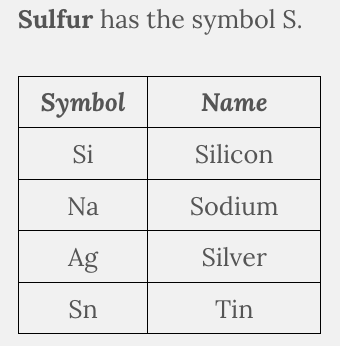
Sulfur

The atomic number, which is the number of protons, is used to identify an element. The atomic number is also used to organize the elements in the periodic table, as the elements are organized by increasing atomic number (or the increasing number of protons).
The mass number, which is typically written as a superscript in front of the elemental symbol, is the number of protons plus neutrons. Because the protons and neutrons are found in the nucleus, the mass number is also the mass of the nucleus. From the mass number and the atomic number, the number of neutrons can also be determined.
In a neutral atom, the number of protons must be equal to the number of electrons, as the protons are positively charged and the electrons are negative charged.
How many protons, neutrons, and electrons are present in the following isotope of neon?
22 Ne
- Protons: 10 Neutrons: 12 Electrons: 12
- Protons: 22 Neutrons: 10 Electrons: 22
- Protons: 12 Neutrons: 10 Electrons: 12
- Protons: 10 Neutrons: 12 Electrons: 10
Protons: 10
Neutrons: 12
Electrons: 10
Ex.
There are 10 protons , 12 neutrons , and 10 electrons present in 22 Ne.
22 Ne has an atomic number of 10, which corresponds to the number of protons. The mass number is 22, which corresponds to the number of protons plus the number of neutrons. By subtracting the atomic number (10) from the mass number (22), the number of neutrons would be 12.
Because the number of protons equals the number of electrons in a neutral atom, the number of electrons must be 10.

Isotopes are atoms of the same element that have the same number of protons but a different number of neutrons. Therefore, isotopes have the same atomic number (number of protons) but a different mass number (number of protons plus number of neutrons). Typically, the mass number is written as a superscript in front of the elemental symbol.
The following designation is used to distinguish different isotopes of an element from one another:
“A” is the mass number, “Z” is the atomic number, and “X” is the chemical symbol of the element.
What is the correct symbol for an ion containing 24 protons, 27 neutrons, and 21 electrons?
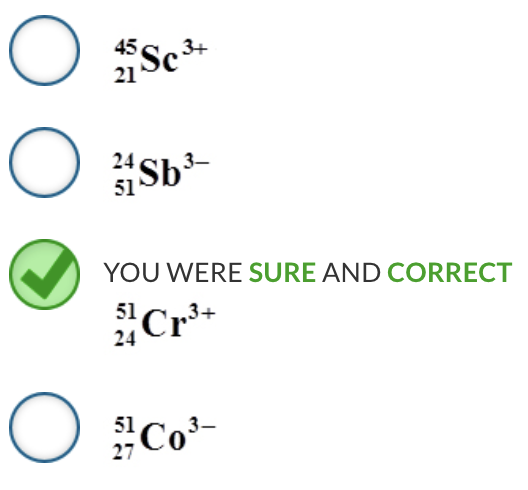
51/24 Cr3+
Ex.
The correct ion is Cr 3+ which will have the symbol:
51/24 Cr3+
The ion has 24 protons, which determines the identity of the element as Cr. The mass number (51) is the sum of the protons (24) plus the neutrons (27). The charge on the ion is determined by the difference in the numbers of protons and electrons. There are 24 protons and 21 electrons. Therefore the charge on the ion is 3+ because there are three more protons than electrons.
What element has the symbol Br? This element is in group 7A(17) which includes nonmetals and metalloids. It is called the halogen group. It has the same outer electron configuration as the other elements in this group, ns 2 np 5.
What element has the symbol Br?
- Bromine
- Beryllium
- Boron
- Barium
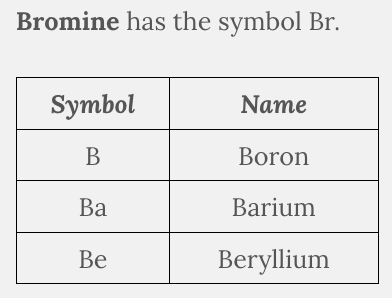
Bromine
What is the symbol for the element copper? Copper is in the early transition metal series which includes group 1B(11). It does not have the predicted outer electron configuration for the group, ns 2(n-1)d 9; it is an exception ns 1(n-1)d 10.
What is the symbol for copper?
- C
- Co
- Cu
- Cr
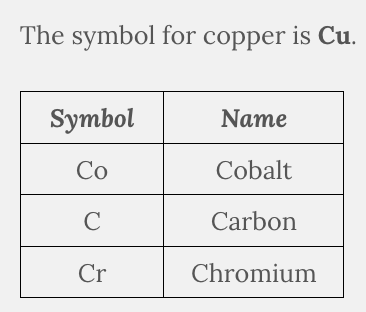
Cu